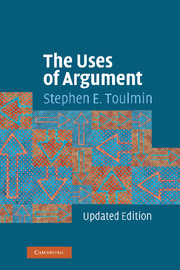Book contents
- Frontmatter
- Contents
- Preface to the Updated Edition
- Preface to the Paperback Edition
- Preface to the First Edition
- Introduction
- I Fields of Argument and Modals
- II Probability
- III The Layout of Arguments
- IV Working Logic and Idealised Logic
- V The Origins of Epistemological Theory
- Conclusion
- References
- Index
Conclusion
Published online by Cambridge University Press: 05 June 2012
- Frontmatter
- Contents
- Preface to the Updated Edition
- Preface to the Paperback Edition
- Preface to the First Edition
- Introduction
- I Fields of Argument and Modals
- II Probability
- III The Layout of Arguments
- IV Working Logic and Idealised Logic
- V The Origins of Epistemological Theory
- Conclusion
- References
- Index
Summary
The first, indispensable steps in any philosophical inquiry are liable to seem entirely negative, both in intention and in effect. Distinctions are made, objections are pressed, accepted doctrines are found wanting, and such appearance of order as there was in the field is destroyed; and what, asks a critic, can be the use of that?
In immediate effect, the philosopher's initial moves do certainly tend to break down rather than build up analogies and connections. But this is inevitable. The late Ludwig Wittgenstein used to compare the re-ordering of our ideas accomplished in philosophy with the re-ordering of the books on the shelves of a library. The first thing one must do is to separate books which, though at present adjacent, have no real connection, and put them on the floor in different places: so to begin with the appearance of chaos in and around the bookcase inevitably increases, and only after a time does the new and improved order of things begin to be manifest—though, by that time, replacing the books in their new and proper positions will have become a matter of comparative routine. Initially, therefore, the librarian's and the philosopher's activities alike are bound to appear negative, confusing, destructive: both men must rely on their critics exercising a little charity, and looking past the initial chaos to the longer-term intention.
- Type
- Chapter
- Information
- The Uses of Argument , pp. 233 - 238Publisher: Cambridge University PressPrint publication year: 2003



